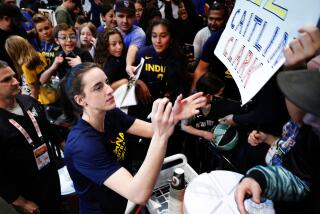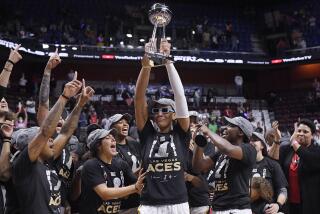ABL Offers the Old, New
Teresa, Kara and a man called “God.”
Those will be the most-watched individuals tonight in Hartford, Conn., when the war in women’s professional basketball resumes after a six-week truce.
In opening the American Basketball League’s second season, former U.S. Olympian Teresa Edwards, player-coach of the Atlanta Glory, leads her team against arguably the women’s game’s greatest pure center, Kara Wolters, who answers to a coach at least one of her teammates calls God.
That would be K.C. Jones, who shocked his NBA brethren last May by signing as coach of the ABL’s New England Blizzard.
Jones, 65, is a huge hit with Blizzard players. In fact, it appears they’re getting a little carried away.
Said Blizzard player Karen Deden: “When K.C. talks to us, it’s like listening to God.”
Whatever, those three highlight the ABL opener tonight on Fox Sports Net, tipping off the league’s 44-game season, six weeks after the end of the WNBA’s 28-game season.
It remains to be seen how well Jones will fare--even with 6-foot-7 rookie Wolters--against a team some are picking to dethrone league champion Columbus.
Atlanta, 18-22 last season, has reloaded with a team that looks crafted from the University of Georgia Hall of Fame. Edwards, 33, teams with 6-3 Georgia rookie Tracy Henderson, 5-7 guard Saudia Roundtree and 6-2 Olympian Katrina McClain.
New England, runaway attendance leader last year at 5,008 a game, (7,412 at Hartford), has sold more than 5,000 season tickets for its 16 games at Hartford Civic Center. It plays six games at Springfield, Mass.
And it has Wolters, called by her college coach, Geno Auriemma of Connecticut, “the most dominant post player in the history of this sport.”
She joins two other UConn standouts, second-year guard Jen Rizzotti and rookie Carla Berube.
The higher-paying ABL (a $150,000 top salary compared to $50,000 in the WNBA) nearly pulled off a clean sweep last spring in its signing battle with the WNBA.
Before it signed Wolters, the league signed Stanford Naismith Award winner Kate Starbird (Seattle), Alabama’s Shalonda Enis (Seattle), Old Dominion’s Clarisse Machanguana (San Jose), Florida’s DeLisha Milton (Portland), Georgia’s La’Keshia Frett (Philadelphia) and Notre Dame’s Beth Morgan (Philadelphia).
The WNBA signed only two premier rookies: USC’s Tina Thompson (Houston) and Kansas’ Tamecka Dixon (Los Angeles).
Even before that, the ABL was considered deeper than the WNBA. The ABL has seven 1996 Olympians, the WNBA five.
But that fifth WNBA Olympian represents a major off-season coup. Last season’s ABL most valuable player, Nikki McCray, signed with the WNBA and will play either with Washington or Detroit next season.
McCray was the second ABL defector. The first was Cindy Brown, who was to have played for the Long Beach StingRays this season. Instead the onetime Long Beach State All-American is playing out her option year in France before entering the WNBA next June.
So by the time ABL players reported to camp the first week of September, the league had retained 97 of its 99 players.
Also in the off-season, the ABL stitched together a TV deal that’s an improvement over last year’s but still not close to WNBA exposure. There will be up to 24 Sunday night ABL games carried by Fox Sports Net, available in about 60 million homes, compared to last year’s Sports Channel deal, which reached 20 million.
The Black Entertainment Television network will televise 12 Saturday night games, beginning Dec. 6.
WNBA games are on NBC, ESPN and Lifetime.
The WNBA has a commanding advantage in corporate sponsorships as well, with about $20 million banked before it played a game.
ABL sponsorship, according to the league, is about a quarter of that, though league CEO Gary Cavalli says he wants to double that figure this season.
At the moment, there are no signs that the two leagues will merge or that the ABL will be absorbed into the WNBA. In fact, in the off-season, the ABL brought in two new investors, Silicon Valley venture capitalist Joe Lacob and Bob Fiondella, CEO of Hartford-based Phoenix Home Life Insurance.
Each infused the league with $3 million, canceling out the $6 million in announced losses from the first season. Lacob now operates the San Jose Lasers. Fiondella says he will take over the Blizzard “in about a year.”
Said Lacob: “Every company I ever invested in lost money at the outset.
“This was a no-brainer. We have the best players, not the other league. The ABL has a big future, anyone should be able to see that.”
The ABL plays primarily in small to medium-size arenas to keep the rent down, so attendance comparisons with the WNBA aren’t all that meaningful.
The ABL says it averaged 3,536 paid league-wide last season and had five games of more than 8,000.
The WNBA averaged 9,669, with 41 crowds more than 10,000 and 10 more than 16,000.
Six of the eight ABL teams last year averaged more than 3,000 paid. Columbus, with the league championship team, came in last (2,682), but even the Quest made major attendance gains late in the season, drawing 6,313 for a playoff game.
This season, Cavalli said, the goal is 5,000 paid per game league-wide. Season ticket sales, he said, are up 50% throughout the league.
More to Read
Go beyond the scoreboard
Get the latest on L.A.'s teams in the daily Sports Report newsletter.
You may occasionally receive promotional content from the Los Angeles Times.










